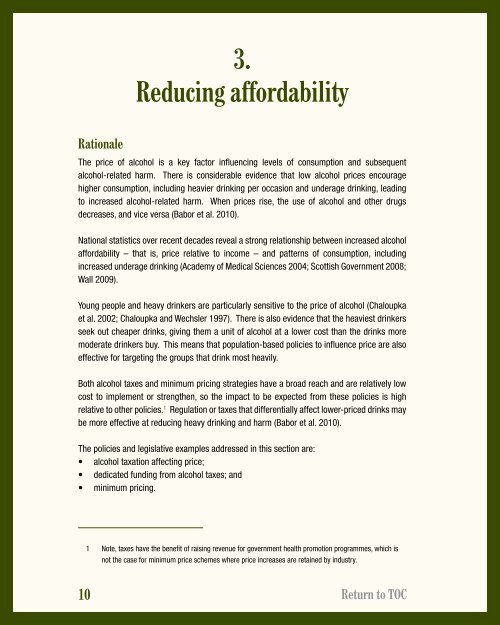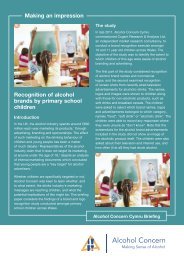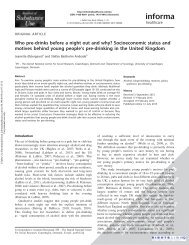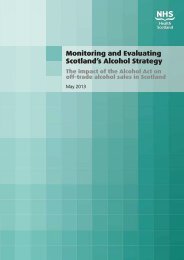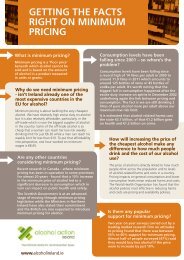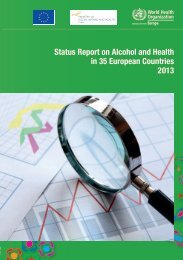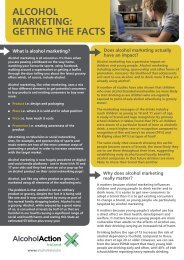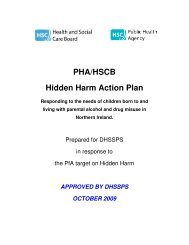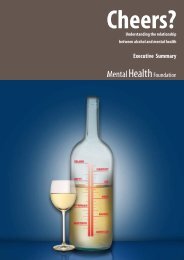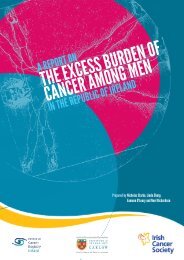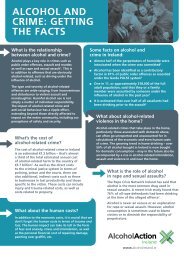Addressing the harmful use of alcohol - WHO Western Pacific Region
Addressing the harmful use of alcohol - WHO Western Pacific Region
Addressing the harmful use of alcohol - WHO Western Pacific Region
You also want an ePaper? Increase the reach of your titles
YUMPU automatically turns print PDFs into web optimized ePapers that Google loves.
3.<br />
Reducing affordability<br />
Rationale<br />
The price <strong>of</strong> <strong>alcohol</strong> is a key factor influencing levels <strong>of</strong> consumption and subsequent<br />
<strong>alcohol</strong>-related harm. There is considerable evidence that low <strong>alcohol</strong> prices encourage<br />
higher consumption, including heavier drinking per occasion and underage drinking, leading<br />
to increased <strong>alcohol</strong>-related harm. When prices rise, <strong>the</strong> <strong>use</strong> <strong>of</strong> <strong>alcohol</strong> and o<strong>the</strong>r drugs<br />
decreases, and vice versa (Babor et al. 2010).<br />
National statistics over recent decades reveal a strong relationship between increased <strong>alcohol</strong><br />
affordability – that is, price relative to income – and patterns <strong>of</strong> consumption, including<br />
increased underage drinking (Academy <strong>of</strong> Medical Sciences 2004; Scottish Government 2008;<br />
Wall 2009).<br />
Young people and heavy drinkers are particularly sensitive to <strong>the</strong> price <strong>of</strong> <strong>alcohol</strong> (Chaloupka<br />
et al. 2002; Chaloupka and Wechsler 1997). There is also evidence that <strong>the</strong> heaviest drinkers<br />
seek out cheaper drinks, giving <strong>the</strong>m a unit <strong>of</strong> <strong>alcohol</strong> at a lower cost than <strong>the</strong> drinks more<br />
moderate drinkers buy. This means that population-based policies to influence price are also<br />
effective for targeting <strong>the</strong> groups that drink most heavily.<br />
Both <strong>alcohol</strong> taxes and minimum pricing strategies have a broad reach and are relatively low<br />
cost to implement or streng<strong>the</strong>n, so <strong>the</strong> impact to be expected from <strong>the</strong>se policies is high<br />
relative to o<strong>the</strong>r policies. 1 Regulation or taxes that differentially affect lower-priced drinks may<br />
be more effective at reducing heavy drinking and harm (Babor et al. 2010).<br />
The policies and legislative examples addressed in this section are:<br />
• <strong>alcohol</strong> taxation affecting price;<br />
• dedicated funding from <strong>alcohol</strong> taxes; and<br />
• minimum pricing.<br />
1 Note, taxes have <strong>the</strong> benefit <strong>of</strong> raising revenue for government health promotion programmes, which is<br />
not <strong>the</strong> case for minimum price schemes where price increases are retained by industry.<br />
10 Return to TOC


